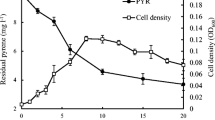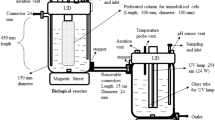Abstract
The Bacillus sp. strain PHN 1 capable of degrading p-cresol was immobilized in various matrices namely, polyurethane foam (PUF), polyacrylamide, alginate and agar. The degradation rates of 20 and 40 mM p-cresol by the freely suspended cells and immobilized cells in batches and semi-continuous with shaken cultures were compared. The PUF-immobilized cells achieved higher degradation of 20 and 40 mM p-cresol than freely suspended cells and the cells immobilized in polyacrylamide, alginate and agar. The PUF- immobilized cells could be reused for more than 35 cycles, without losing any degradation capacity and showed more tolerance to pH and temperature changes than free cells. These results revealed that the immobilized cell systems are more efficient than freely suspended cells for degradation of p-cresol.


Similar content being viewed by others

References
Bayly RC, Dagley S, Gibson DT (1966) The metabolism of cresols by species of Pseudomonas. Biochem J 101:293–301
Bettmann H, Rehm HJ (1984) Degradation of phenol by polymer entrapped microorganisms. Appl Microbiol Biotechnol 20:285–290. doi:10.1007/BF00270587
Cassidy MB, Lee H, Trevors JT (1996) Environmental applications of immobilized microbial cells: a review. J Ind Microbiol 16:79–101. doi:10.1007/BF01570068
D’Souza SF (2002) Trends in immobilized enzyme and cell technology. Indian J Biotechnol 1:321–328
Hall DO, Rao KK (1989) Immobilized photosynthetic membranes and cells for the production of fuels and chemicals. Chim Oggi 1:41–47
Hopper DJ, Taylor DG (1975) Pathways for the degradation of m-cresol and p-cresol by Pseudomonas putida. J Bacteriol 122:1–6
Hutchinson DH, Robinson CW (1988) Kinetics of the simultaneous batch degradation of p-cresol and phenol by Pseudomonas putida. Appl Microbiol Biotechnol 29:599–604. doi:10.1007/BF00260991
Jonathan W (1988) Methods of immobilization of microbial cells. J Microbiol Methods 8:91–102. doi:10.1016/0167-7012(88)90041-3
Jones KH, Trudgill PW, Hopper DJ (1993) Metabolism of p-cresol by the fungus Aspergillus fumigatus. Appl Environ Microbiol 59:1125–1130
O’ Reilly KT, Crawford RL (1989) Kinetics of p-cresol degradation by an immobilized Pseudomonas sp. Appl Environ Microbiol 55:866–870
Tallur PN, Megadi VB, Kamanavalli CM, Ninnekar HZ (2006) Biodegradation of p-Cresol by Bacillus sp. strain PHN 1. Curr Microbiol 53(6):529–533. doi:10.1007/s00284-006-0309-x
Trevors JT, Van Elsas JD, Lee H, Van Overbeek LS (1992) Use of alginate and other carriers for encapsulation of microbial cells for use in soil. Microb Releases 1:61–69
Author information
Authors and Affiliations
Corresponding author
Rights and permissions
About this article
Cite this article
Tallur, P.N., Megadi, V.B. & Ninnekar, H.Z. Biodegradation of p-cresol by immobilized cells of Bacillus sp. strain PHN 1. Biodegradation 20, 79–83 (2009). https://doi.org/10.1007/s10532-008-9201-7
Received:
Accepted:
Published:
Issue Date:
DOI: https://doi.org/10.1007/s10532-008-9201-7



